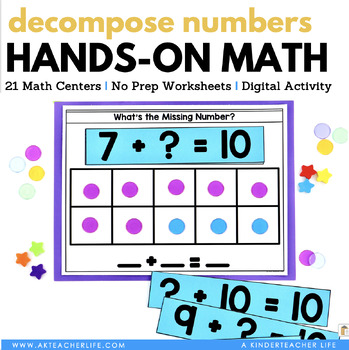Decomposing Numbers Math Centers
A Kinderteacher Life
9k Followers
Grade Levels
K - 2nd
Subjects
Resource Type
Standards
CCSSK.OA.A.1
CCSSK.OA.A.2
CCSSK.OA.A.3
CCSSK.OA.A.4
CCSS1.OA.A.1
Formats Included
- PDF
Pages
182 pages
A Kinderteacher Life
9k Followers
What educators are saying
I use these resources in math intervention and it has been a life saver as I'm new to early childhood. There are so many activities and it is extremely well laid out and organized. It is worth the money!
This was a great resource! I used it for kindergarten centers with decomposing numbers. It was engaging and simple to set up!
Also included in
- Math Centers for Kindergarten hands-on activities and digital games made for Google Slides and PRELOADED to SeesawBuy the bundle and save 40%As teachers, we often need more resources to teach our students. These math centers are all you need to teach every Common Core standard for Kindergarten usingPrice $80.00Original Price $165.00Save $85.00
- Math Centers for Kindergarten Bundle: Hands-on Activities and Digital GamesExplore these comprehensive math centers for Kindergarten that encompass engaging hands-on activities and digital games designed for Google Slides and PRELOADED to Seesaw. Concepts CoveredHands-on, standards-based activitiesCPrice $80.00Original Price $139.50Save $59.50
Description
Decomposing and Composing Math Centers include engaging hands-on activities and digital activities and digital activities to teach concepts of decomposing numbers to teach decomposing numbers concepts.
This resource seamlessly integrates into whole group activities, math centers, and small group instruction, making it a valuable complement to any curriculum.
Save BIG when you BUY THE BUNDLE (30% OFF)
Concepts Covered:
- Provide comprehensive practice in breaking numbers into parts
- Decomposing a number in multiple ways
- Solving word problems
- Finding the number that makes 5 or 10
- Decomposing a number using objects, pictures, and words
Resource Highlights:
- Show It Three Ways
- Slide and Decompose
- Show and Decompose
- Part-Part-Whole
- Number Bond Mat
- Build and Decompose
- Giant Number Bond
- Number Towers
- What’s The Missing Number?
- Make It Three Ways
- Number Puzzles: Set 1
- Number Puzzles: Set 2
- Solve and Cover
- Spin and Cover
- The Cumulative Property
- Math Talk Mat
- Act It Out
- Space Journey to Make 5
- Number Bond Mystery
No Prep Printables Included
- Build It and Break It
Digital Learning
- Decomposing Numbers Digital Activity
Explore More:
Decomposing Teen Numbers into Ten and Some Ones
Decomposing Numbers 5 - 10 The Bundle
First Grade Math Centers: The Bundle
Questions?
You can ask a question using "Product Q&A" or email me at akteacherlife@gmail.com.
Be sure to follow A Kinderteacher Life:
- Visit my blog at A Kinderteacher Life
- Follow me on TpT
- Follow me on Instagram
- Follow me on Facebook
Total Pages
182 pages
Answer Key
N/A
Teaching Duration
N/A
Report this resource to TPT
Reported resources will be reviewed by our team. Report this resource to let us know if this resource violates TPT’s content guidelines.
Standards
to see state-specific standards (only available in the US).
CCSSK.OA.A.1
Represent addition and subtraction with objects, fingers, mental images, drawings, sounds (e.g., claps), acting out situations, verbal explanations, expressions, or equations.
CCSSK.OA.A.2
Solve addition and subtraction word problems, and add and subtract within 10, e.g., by using objects or drawings to represent the problem.
CCSSK.OA.A.3
Decompose numbers less than or equal to 10 into pairs in more than one way, e.g., by using objects or drawings, and record each decomposition by a drawing or equation (e.g., 5 = 2 + 3 and 5 = 4 + 1).
CCSSK.OA.A.4
For any number from 1 to 9, find the number that makes 10 when added to the given number, e.g., by using objects or drawings, and record the answer with a drawing or equation.
CCSS1.OA.A.1
Use addition and subtraction within 20 to solve word problems involving situations of adding to, taking from, putting together, taking apart, and comparing, with unknowns in all positions, e.g., by using objects, drawings, and equations with a symbol for the unknown number to represent the problem.







